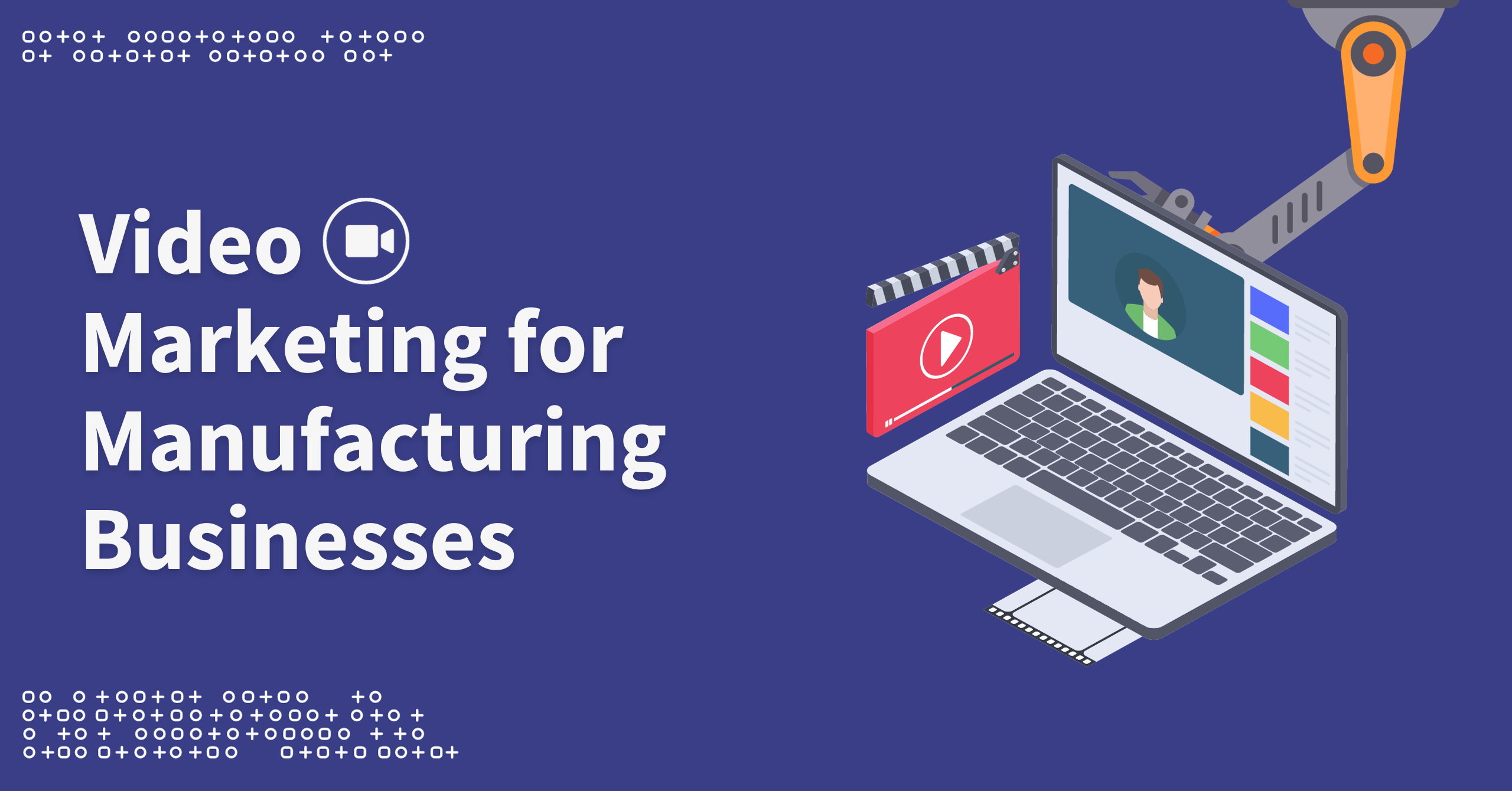Table Of Contents
Imagine having a powerful tool that not only captures attention but guides your audience seamlessly from awareness to conversion. That tool is video, and it’s time to harness its full potential.
In the manufacturing sector, where intricate details matter, video content serves as an effective tool for educational purposes, enabling companies to create tutorials and product demonstrations.
In this expert guide, we’re diving deep into the secrets of video marketing for manufacturing companies. We’ll explain how you can use it strategically at every stage of the buyer’s journey, from creating a memorable first impression to sealing the deal and retaining loyal customers
How Video Can Be Used as a Marketing Tool
Video can be strategically used at each stage of the buyer’s journey to engage, attract, and convert audiences:
Awareness Stage:
Engagement and Brand Awareness: At the beginning of the buyer’s journey, use videos to capture attention and introduce your brand. Focus on creating emotionally resonant and visually appealing content to establish a memorable first impression.
Interest Stage:
Educational Content: As potential customers move into the interest stage, provide informative videos that address their pain points or challenges. These videos should aim to educate and position your brand as a valuable resource, building trust and credibility.
Consideration Stage:
Product Demonstrations: In the consideration stage, potential customers are actively exploring solutions. Use videos to showcase your products or services in action. Highlight key features and benefits to help prospects understand how your offerings meet their needs.
Intent Stage:
Testimonial and Case Study Videos: As prospects move closer to making a decision, share video testimonials and case studies. Hearing from satisfied customers can provide social proof and alleviate concerns, helping to solidify the decision to move forward.
Purchase Stage:
Promotional Videos and Offers: At the point of purchase, create videos that communicate special promotions, discounts, or exclusive offers. These videos should serve as the final incentive for prospects to convert into customers.
Post-Purchase Stage:
Onboarding Videos: After a purchase, use onboarding videos to guide customers on how to use your products or services effectively. This not only enhances the customer experience but also helps prevent any post-purchase confusion or dissatisfaction.
Retention and Advocacy:
Exclusive Content for Customers: To encourage customer loyalty, provide exclusive video content, such as advanced tutorials, tips, or behind-the-scenes footage. This can turn customers into advocates who may refer others to your brand.
By aligning your video content with the specific needs and mindset of the audience at each stage of the buyer’s journey, you can create a cohesive and compelling narrative that guides them seamlessly from awareness to conversion.
How to Use Video Marketing for Lead Generation
Lead generation does not exist in vacuum. We always teach our clients that the growth comes from following a very specific formula.
Acquisition + Retention = Growth.
When we think about the importance of videos for lead generation, we want to think about it in the context of the four elements of that formula: capturing existing demand, creating demand and increasing awareness, managing and nurturing leads, and managing and nurturing customers.
Capture Existing Demand:
In this stage, video serves as a tool to capture and retain the attention of an audience already expressing interest in your products or services. Utilize videos to succinctly showcase key features, highlight customer testimonials, and provide quick overviews that reinforce the value proposition, encouraging potential customers to move further down the funnel.
Create Demand and Increase Awareness:
Video plays a pivotal role in creating demand and increasing awareness. Develop compelling content that introduces your brand, explains unique selling points, and addresses pain points of your target audience. Engaging explainer videos, educational content, and visually appealing brand stories are essential to capture the attention of a wider audience and foster interest.
Manage and Nurture Leads:
As leads enter the nurturing phase, video content becomes a dynamic tool for maintaining engagement. Create personalized videos that guide leads through specific aspects of your offerings, addressing their concerns and providing valuable information. Utilize webinars and in-depth product demonstrations to deepen their understanding and build trust, ultimately moving them closer to conversion.
Manage and Nurture Customers:
Post-conversion, the role of video shifts towards customer satisfaction and retention. Develop onboarding videos to facilitate a smooth customer initiation. Provide educational resources, such as tutorials and how-to videos, to enhance the customer experience. Additionally, use video content to communicate updates, exclusive offers, and success stories, fostering an ongoing relationship and transforming customers into advocates for your brand.
By strategically incorporating video at each of these four stages, you can optimize its impact on your marketing efforts. Video content serves as a versatile medium that not only attracts new prospects but also nurtures and retains them, contributing to a holistic and effective marketing strategy.
Creating a Manufacturing Video Marketing Strategy
Define Your Objectives
Begin by setting clear and measurable goals. Whether it’s brand awareness, product promotion, or increased engagement, a well-defined objective is the foundation of a successful strategy.
Know Your Audience
Deepen your understanding of your target audience. Identify their pain points, preferences, and behaviors to tailor your content effectively.
Choose the Right Style
Align the style of your videos with your brand identity and the preferences of your audience. Whether it’s informational, emotional, or educational, consistency is key.
Select Distribution Channels
Choose platforms strategically based on your audience’s online habits. Whether it’s YouTube, LinkedIn, or your website, focus on platforms that align with your marketing goals.
Create a Content Calendar
Plan your video releases systematically. A well-structured content calendar ensures consistency, keeps your audience engaged, and enhances your brand’s visibility.
Optimize for SEO
Enhance the discoverability of your videos by incorporating relevant keywords in titles, descriptions, and transcripts. SEO optimization is integral to maximizing your video’s impact.
Engage Your Audience
Foster a sense of community around your brand by actively engaging with your audience through comments, shares, and discussions. This interaction builds trust and loyalty.
Analyze and Adapt
Regularly analyze video metrics to understand what resonates with your audience. Use this data to adapt your strategy continuously and improve the effectiveness of your video content.
How do you promote a product in a video?
Below are some video ideas for manufacturers:
Product Demos
Present a detailed walkthrough of your product, highlighting its features and functionality.
Behind-the-Scenes
Offer a glimpse into your manufacturing process, emphasizing the craftsmanship and dedication behind your products.
Customer Testimonials
Feature satisfied clients sharing their success stories, building authenticity and trust.
Problems & solutions
Provide a step-by-step visual account of your manufacturing process, explaining how your product solves the common challenges.
Tutorials and Innovative Applications
Showcase use cases of your products, inspiring your audience with the versatility of your offerings.
How Does Video Improve My SEO?
Video can have a positive impact on your search engine optimization (SEO) efforts in several ways:
Increased Engagement
Videos are inherently more engaging than text-based content. Users tend to spend more time on pages that include videos, which can reduce bounce rates and improve overall user engagement metrics. Search engines often prioritize pages with higher engagement in their rankings.
Diversified Content
Search engines like Google aim to provide a diverse range of content types in search results. By incorporating videos into your content strategy, you can diversify your content and increase the likelihood of ranking well in search results.
Rich Snippets
Google often displays rich snippets, which include video thumbnails, in search results. If your page includes a video, it may appear as a rich snippet, making your result more visually appealing and potentially attracting more clicks.
YouTube SEO
If you host your videos on YouTube (which is owned by Google), optimizing your videos for YouTube search can indirectly impact your overall SEO. YouTube videos can also appear in Google search results, providing additional opportunities for visibility.
Backlinks and Social Shares
Compelling videos have the potential to attract backlinks and social shares. When other websites link to your video content, it can positively impact your site’s authority and SEO. Social shares can also contribute to increased visibility and traffic.
Improved Dwell Time
Dwell time, the amount of time visitors spend on your site, is an important SEO metric. Videos can increase dwell time, especially if users watch the entire video or spend more time on your site exploring related content.
Mobile Optimization
With the increasing use of mobile devices, video content is well-suited for on-the-go users. Search engines often prioritize mobile-friendly content, and videos that are optimized for mobile can enhance the user experience, positively impacting SEO.
Keyword Optimization
Just like with text content, you can optimize videos for relevant keywords. Use descriptive titles, captions, and video transcripts to provide search engines with context about your video’s content.
Local SEO
If your business has a physical location, video content can be used to enhance local SEO efforts. Create videos that showcase your products or services, share customer testimonials, or highlight local events to attract local searches.
Remember that while videos can contribute to SEO, it’s essential to create high-quality, relevant, and valuable content. Also, ensure that your videos are properly optimized for search engines by incorporating relevant keywords, creating descriptive titles and descriptions, and providing transcripts when possible.
Getting Started With Manufacturing Video Marketing
Ready to dive into manufacturing video marketing? Whether you need help understanding your customers, attracting new ones, keeping the ones you have, or growing your business, we’re here to team up with you. Let’s start the conversation! Schedule a consultation with us today to begin improving your marketing.






